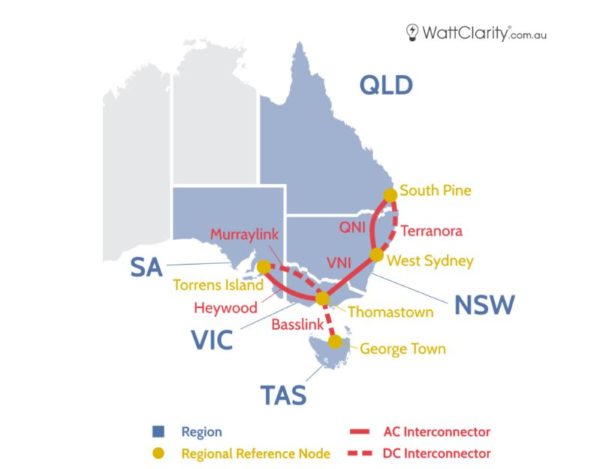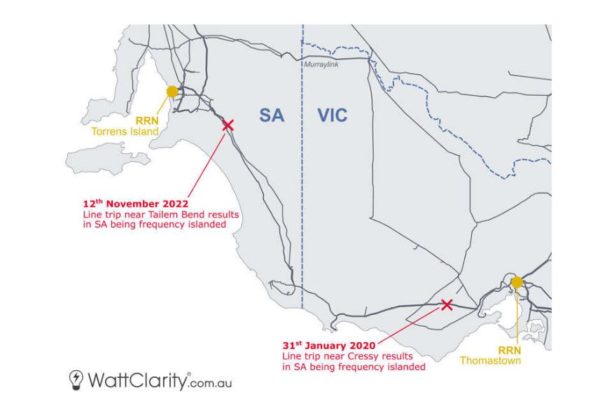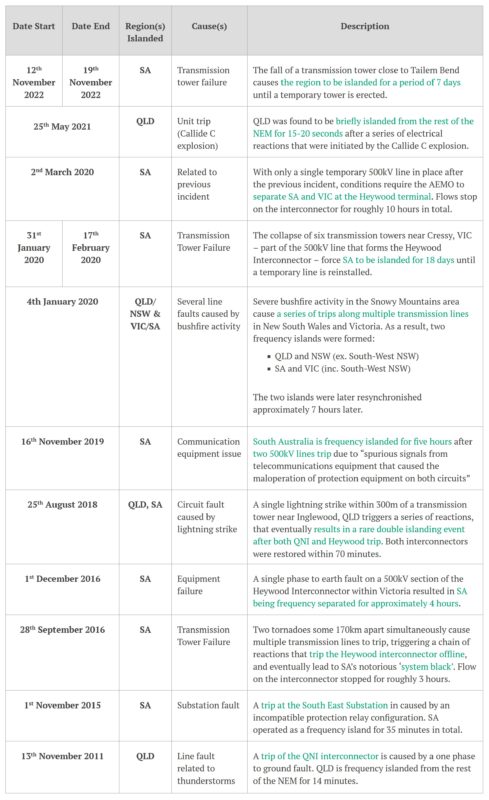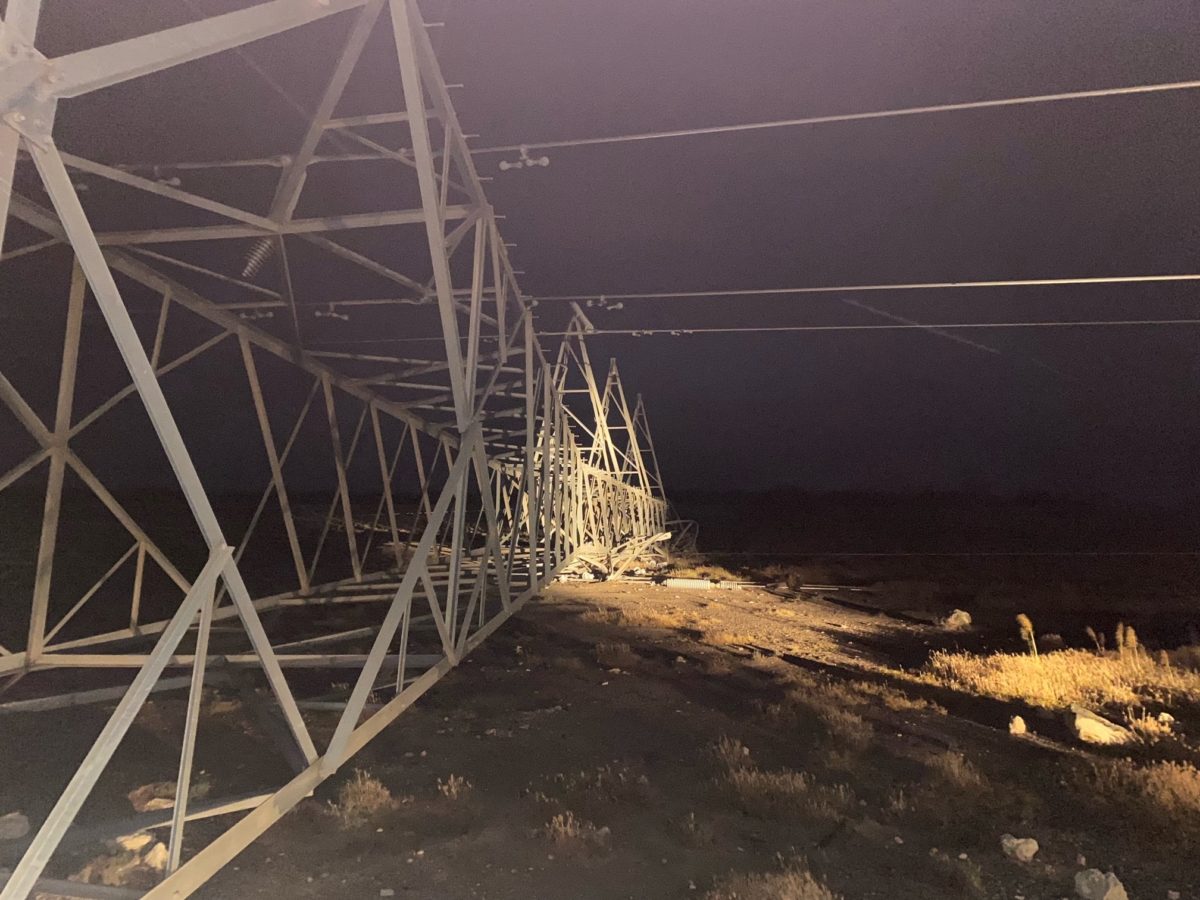In recent months, two unrelated incidences of transmission tower failure resulted in separations within the National Electricity Market (NEM): In South Australia (SA), thunderstorms and strong winds toppled a transmission tower near Tailem Bend. This resulted in a trip of the Heywood interconnector and caused the SA region to be ‘frequency islanded’ for one week.
In Tasmania, a landslide displaced the foundations of a transmission tower near the town of Poatina. The adjoining line is a key part of the transmission backbone that connects the northern and southern parts of the state’s network. Both events temporarily elevated the level of risk in operating the power system securely. And the SA incident in particular, incurred significant market costs to the tune of $31.5 million until the line was restored.
In this article, I will provide some context about interconnectors and examine how they relate to recent islanding events. I will finish by presenting a list of known transmission tower failures for comparison.
Interconnectors
Interconnectors are the bridges that link the five regions together and allow for inter-regional exports and imports. However, unlike a bridge, they are not so much a single physical structure. They are, instead, a construct of the mathematical model that underpins the NEM (i.e. the NEM Dispatch Engine).

Image: Watt Clarity
There are currently six interconnectors in the NEM, and they come in two forms:
· DC (Direct Current) – Basslink (Tasmania to Victoria), Murraylink (Victoria to SA) and Terranora (NSW to Queensland).
· AC (Alternating Current) – Heywood (Victoria to SA), VNI (Victoria to NSW) and QNI (NSW to Queensland).
It’s probably easier to conjure up an image of a DC interconnector, as the infrastructure itself is more-or-less a discrete cable (or group of cables) from one region to another with a terminal on either end.
AC interconnectors on the other hand are more abstract. In these cases, the ‘interconnector’ is all parts of a long complex series of essential transmission lines that connect one Regional Reference Node (RRN) to another, and it can even be the aggregate flow of several cross-regional transmission paths.
It is these AC interconnectors that maintain a common system frequency across regions, as the DC interconnectors have no such ability. A key benefit of AC interconnection is that some tasks (such as procuring enough energy to manage system frequency) can be shared across regions. However, an unexpected trip of one of these interconnectors can lead to rather large system security issues, price spikes and other economic consequences as one region is suddenly ‘on its own’ to manage supply, frequency, and the other complexities of operating an independent electricity grid.
Islanding events
As one observant WattClarity reader recently noted, the term ‘islanding’ is often used interchangeably to refer to one of three different types of events that can occur in the NEM:
· Economic islanding – When all (AC and/or DC) interconnectors between two regions are constrained, economic islands are formed on either side as regional spot prices can separate (sometimes significantly). E.g. If the VNI was the only interconnector in the NEM to be bound, NSW and Queensland would form one economic island and Victoria, SA and Tasmania would form another.
· Frequency islanding –When one or more regions lose frequency synchronisation, generally because an AC interconnector(s) is offline, a frequency island forms. E.g. If Heywood is offline but Murraylink is online, SA is frequency islanded.
· Electrical islanding – When all (AC and/or DC) interconnectors linked to a region are offline, an electrical island forms. E.g. If QNI and Terranora are both offline simultaneously, Queensland is electrically islanded.
Economic islandings occur often, while frequency and electrical islandings are rare and need to be managed carefully when they do occur. The event we saw in South Australia last month was the second major case within three years that SA was ‘frequency islanded’ from the rest of the NEM for an extended period of time. In a somewhat similar incident in January 2020, a transmission tower collapse on the Victorian side of the border caused the trip of Heywood, leaving behind a $90 million + FCAS bill in the process.
Islandings of this type are a particular concern for South Australia. As a region that deals with comparatively high levels of Variable Renewable Energy penetration and periods of ultra-low (or even ‘negative’) demand, the dynamics of its power system change dramatically when it is unexpectedly islanded in this way.

Image:WattClarity
If you remember, an interconnector is any part of a series of essential lines that connect two RRNs – the image above may help to depict the physical extent of the Heywood interconnector and show how two very geographically different tower collapses could cause similar contingency events.
Of course, it is not always the case that tower failure is the root cause of an islanding event as there are thousands of electrical components that compose what is mathematically modelled as an interconnector. The table below has been compiled to list all known frequency islanding events in the NEM back to 2010.

As Queensland and SA have only one AC interconnection with their neighbours (and both contain single double-circuited transmission lines), the risk of a frequency islanding event is elevated. The risk is much lower in NSW and Victoria as multiple geographically dispersed lines would need to trip simultaneously. This may also be the case for SA, once Project EnergyConnect is completed in the coming years.
Without AC interconnection, Tasmania is not frequency synchronised with the mainland regions (hence technically always ‘frequency islanded’) although Basslink’s technology uniquely does allow for transfer of FCAS. The region has to deal with its own set of issues when Basslink is completely offline (i.e. when it becomes ‘electrically islanded’) as was the case for an extended period in 2016.
Transmission tower failures
The second component of SA’s islanding event was the collapse of a tower that carried a critical transmission line. A combination of factors can be involved in a transmission tower failure such as extreme weather events, corrosion, structural inadequacy, engineering defects or even sabotage. In Australia, it has been mother nature who has delivered the most knockout blows to the transmission network.
Depending upon location on the network, these incidents have had varying levels of impact on supply and security. While bushfires and flooding can affect structures in other ways, it’s more commonly wind-related events that have been their (literal) downfall. A 2020 CSIRO case study examined the risks of severe convective winds to transmission towers. The report highlighted that in relation to Australia’s aging transmission network, “Maintenance and upgrades consider several factors, including exposure, history of failure and physical condition of the tower, but generally towers are not systematically upgraded to today’s engineering standards.”.
Finally, it’s important to keep in mind that the list above only relates to such events on a transmission level. I can imagine that the list of incidents on the distribution network is an order of magnitude longer.
Final conclusions
Hopefully this has helped paint a picture of how often these unexpected events have unfolded and how they pose significant risks to the power system. By looking at the timelines presented above, there may be some key lessons that we can take away:
- The number of possible contingency events that system planners and operators need to consider is enormous. Even the most abnormal event could present substantial system security concerns and economic repercussions without notice.
- The existing transmission network is aging. An AusNet Services report from July 2020 stated that the then-average age of transmission structures in Victoria was 52.6 years (the expected service life is 70 years).
- The NEM is becoming increasingly dependent on weather – and in ways that you might not expect. Transmission path diversity, proper maintenance, corrosion monitoring, etc. can mitigate risks to the physical network, but extreme weather events and natural disasters are inevitable, and conceivably more so with a changing climate. While we prepare for ‘when the wind doesn’t blow’, perhaps we shouldn’t forget what can happen ‘when the wind does blow’.
Author: Dan Lee, analyst, Global Roam
This article first appeared in WattClarity by Global Roam and is reproduced here with permission.
The views and opinions expressed in this article are the author’s own, and do not necessarily reflect those held by pv magazine.
This content is protected by copyright and may not be reused. If you want to cooperate with us and would like to reuse some of our content, please contact: editors@pv-magazine.com.








By submitting this form you agree to pv magazine using your data for the purposes of publishing your comment.
Your personal data will only be disclosed or otherwise transmitted to third parties for the purposes of spam filtering or if this is necessary for technical maintenance of the website. Any other transfer to third parties will not take place unless this is justified on the basis of applicable data protection regulations or if pv magazine is legally obliged to do so.
You may revoke this consent at any time with effect for the future, in which case your personal data will be deleted immediately. Otherwise, your data will be deleted if pv magazine has processed your request or the purpose of data storage is fulfilled.
Further information on data privacy can be found in our Data Protection Policy.